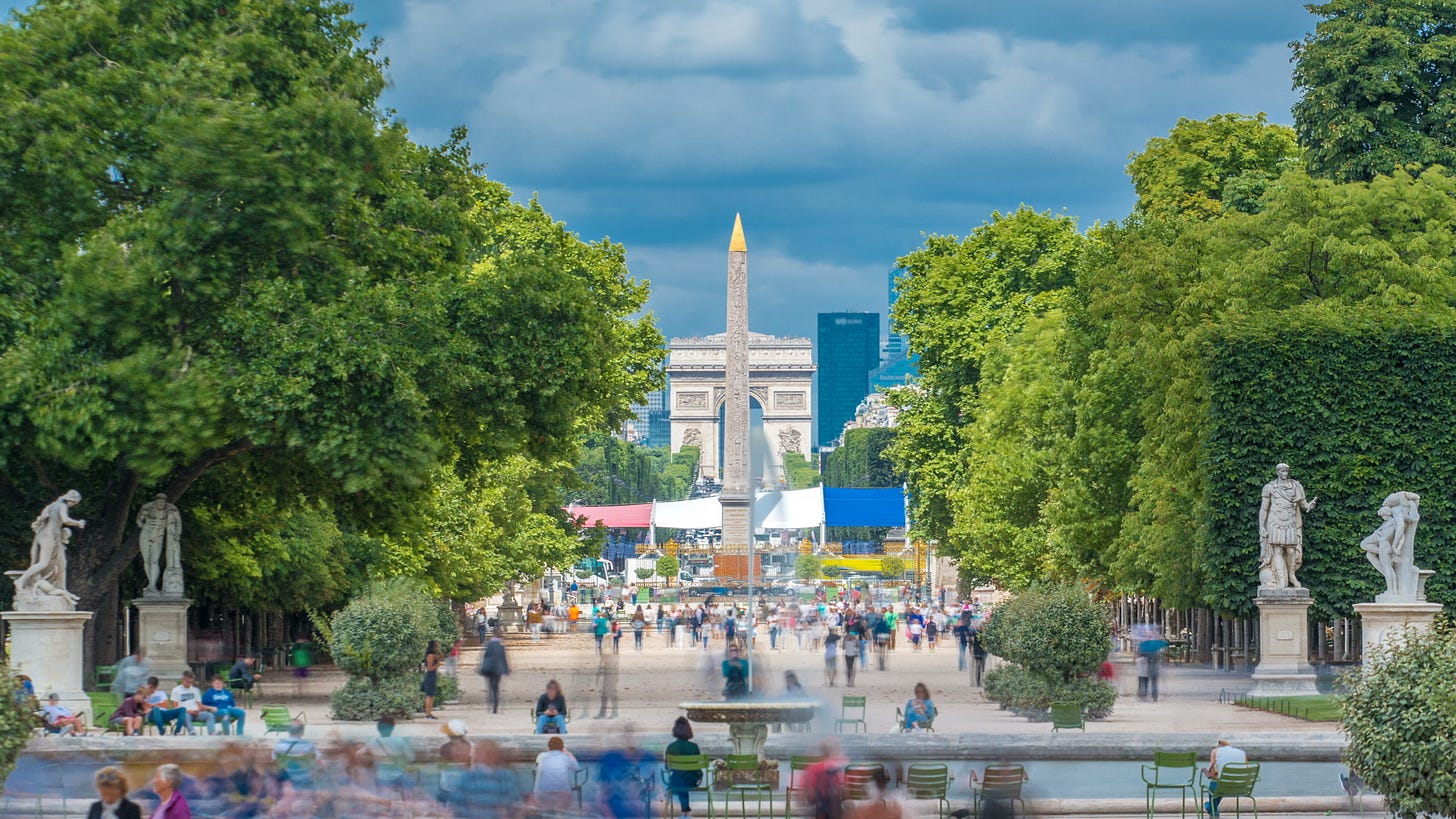Welcome
Welcome to Paris Monument Week.
Like a lot of European cities that have a long, rich and varied history, Paris seems to have something to look at on almost every corner in the main areas of the city.
As I have said every week so far, there are so many options to choose from that narrowing it down to the few in this issue, seems like I am robbing you of all there is to really see!
While two of them are actually places to ‘visit’ a few are just drive or walk – by thing to see.
Thanks to all of you who have told me how much you are enjoying our virtual journey around Paris, I’m enjoying taking you all with me.
Until next week, enjoy Traveling Through History.
Michelle
Savvy Travel Historian
Parisian Monuments
Arc de Triomphe

The Arc de Triomphe de I’Étoile, meaning ‘Triumphal Arch of the Star’, is one of Paris’ most famous monuments.
It stands at the western end of the Champs-Élysées, in the centre of what is now known as Place Charles de Gaulle. It was formerly known as the Place de I’Étoile, because of the twelve radiating avenues that veer off of it.

The Arc forms part of the ‘Axe historique’, a line of monuments, buildings, and thoroughfare’s that extend to the west, from the centre of Paris.
The arch was created to honour those who died in the French Revolutionary and Napoleonic Wars. The names of the French victories and associated generals are inscribed on it.

The Arc was designed by French architect Jean Chalgrin in 1806 and inaugurated in 1836.
The design is based on the Arch of Titus in Rome and is a neoclassical variation.
The tomb of the unknown soldier was placed there in 1920, on Armistice Day, and an eternal flame burns in the memory of the dead that were never identified.

Prior to this, victorious armies marched under the arch, but out of respect to the unknown soldier’s grave, they now march around the arc to the other side. Even Hitler observed this custom when he entered Paris in 1940.
When they visited Paris, President and Mrs Kennedy paid their respects at the grave and she remembered the eternal flame and liked it so much that after JFK was killed, she had an eternal flame placed next to his grave in Arlington National Cemetery in Virginia.
The ceiling of the Arc has 21 sculptured roses on it.

The climb to the top provides views that are well worth seeing, especially at night.

Because it is located not far from the Eiffel Tower, the Arc can be seen in all its glory from it, especially at night.

Relevant Travel Information:
https://www.paris-arc-de-triomphe.fr/en

You can exit the Metro at Charles de Gaulle station and walk to the Arc via an underpass, as crossing the busy road sections are too dangerous.
A lift takes you part-way up to the attic level that has a small museum, then it is 40 steps to the top.
Open 10am – 10:30pm – October -March
10am – 11pm – April – September.
Last entry 45 minutes before close.
Free for museum pass holders, €13 for adults.
Tickets
https://tickets.monuments-nationaux.fr/en-GB/session-products
Napoleon’s Tomb – Musée de I’Armée - Invalides

The tomb of the Emperor Napoleon I is located in an open crypt under the dome of the royal chapel at Les Invalides. Built in the 1600s and finished in 1706, it is one of the most recognised domes in France.

Begun in 1840, the monument took two decades to complete, eventually finished during the reign of Napoleon III in 1861.
The sarcophagus is made from a Russian quartzite and rests upon a base of green granite, which is resting on a slab of black marble. Stone from no fewer than 10 different quarries was used from around France, Russia and included Carrara Mable.

Tsar Nicholas I’s permission was required to use the Russian marble and the project took so long due to the complexities of the exceptional stone required.
In 1840, Napoleon’s remains were moved from Saint Helena (where he had died in 1821) and were laid in a nearby chapel, Saint Jerome, to wait for his tomb to be completed.

The circular layout is adorned by twelve pillars representing victories he had.
The dome above is spectacular and you can view it and the tomb from ground level or from the first-floor gallery as the tomb has been dug right in the centre of it.


The body of Napoleon II was returned to France (he died in Austria in 1832) and placed here, after advice given to Adolf Hitler from the French Ambassador to France in 1940.

In his last will and testament, Napoleon requested that he be buried in France, near the Seine, and an inscription of this is placed near the tomb. (Where he says ‘ashes’ here, he means mortal remains). He said:

“It is my wish that my ashes may repose on the banks of the Seine, in the midst of the French people, whom I have loved so well.”
Fun Fact: The Director of the museum is officially known as ‘the Keeper of the Emperor’s Tomb’!
Relevant Travel Information:
The Tomb of Napoleon is accessed via the Musée de I’Armée.

https://www.musee-armee.fr/en/your-visit/museum-spaces/dome-des-invalides-tomb-of-napoleon-i.html
Open daily from 10am – 6pm
There are a number of ways to get to Les Invalides and they are found here:
https://www.musee-armee.fr/en/your-visit/how-to-get-here.html

Tickets
https://billetterie.musee-armee.fr/en-GB/products
Luxor Obelisk

Located in Place de la Concorde, the ‘Luxor Obelisk’ is one of a pair that were out the front of the Temple of Luxor in Egypt.
Made from a single piece of red granite and measuring 23 metres high, it weighs approximately 227 tonnes and is over 3,000 years old. Both objects are marked with hieroglyphics.

The pair were the largest obelisks erected by Ramses II in Egypt and the first one arrived in Paris in May 1833. It was raised in its current position on October 25 that year watched on by King Louis-Philippe I and a large crowd.
The two obelisks were originally promised to England, but diplomatic negotiations meant they eventually ‘belonged’ to France.
The shorter of the two was transported first in a ship built especially for the journey and the cost was thought to be around 2.5 million Francs (around US$19m today) and this may be why the second one was not collected.
The site where it stands (Concorde), was the main site of the guillotine during the French Revolution.
The gold ‘cap’ at the top of the obelisk was added in 1998 as it was believed they would originally have had them, in situ, and may have been stolen in the 500s BC.

It is clear when looking at the photo above of the Temple in Luxor, that the obelisk was on the right-hand side of the entrance, and we can observe the damage done to the base as it was removed.
The French still ‘owned’ the second obelisk in Egypt, but in 1981, Present Francois Mitterrand, renounced possession of it.
Relevant Travel Information:

Located at the end of the Champs Elysées, the obelisk, right in the centre of the Place de la Concorde, lines up perfectly with the Arc du Triomphe when viewed from the Jardin de Tuileries Garden.
You can go there day or night.

Fontaine du Palmier

Located in the centre of Place du Châtelet (at the north end of Pont au Change), this monumental fountain was one of fifteen commissioned to celebrate Napoleon’s battle victories and to provide fresh drinking water to the neighbouring population.
Completed in 1808, it was designed by engineer Francois-Jean Bralle, who, at the time, was in charge of fountains and water supply during the First Empire.
The circular base is 6m in diameter and it has an 18m tall column that rises in the centre shaped like a palm tree (from which it gets its name). It was modelled after a Roman triumphal column.
It is the one of the oldest surviving from that era.

The top of the statue features ‘Victory’, (made of gilded bronze) carry in each hand the laurels of victory. Because of the wings, people often mistake her for a bird.

Some of Napoleon’s victories are carved in the column, in bronze bands, and is surrounded at its base by four statues representing vigilance, justice, strength and prudence.

The lower base of the fountain was added later (1858) and four Egyptian sphinxes that spout water (which we couldn’t see as it had no water when we visited) were added to commemorate Napoleon’s victories in Egypt.
Relevant Travel Information:
You can reach the fountain either by walking, on a bus or via the closest Metro station Châtelet, which has 5 different train lines running through it.


Michelle is a speaker, author, content marketer, historian and mother of 3 boys.
After 25 years in business and as the ‘Content Marketing Queen’ for the past 12 years, she has helped countless small businesses understand and develop their content strategies and focus on a customer first approach.
Savvy Travel Historian is her passion project, and her weekly newsletter is available on Substack, Paragraph and Mirror. The latter two allows you to collect each Issue as an NFT.
Michelle is co-host of the Web3 By Three Podcast, a weekly show which talks about current stories in the Web3 space and how it applies to B2B marketing, sales and operations. The show is recorded live every Wednesday at 4pm EST/ 9pm UTC on LinkedIn, YouTube & Bolt+.
You can follow Michelle in these places:
Savvy Travel Historian Instagram

